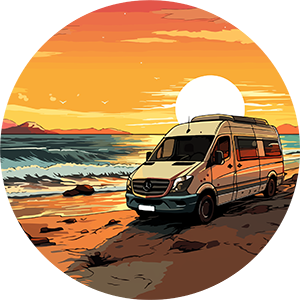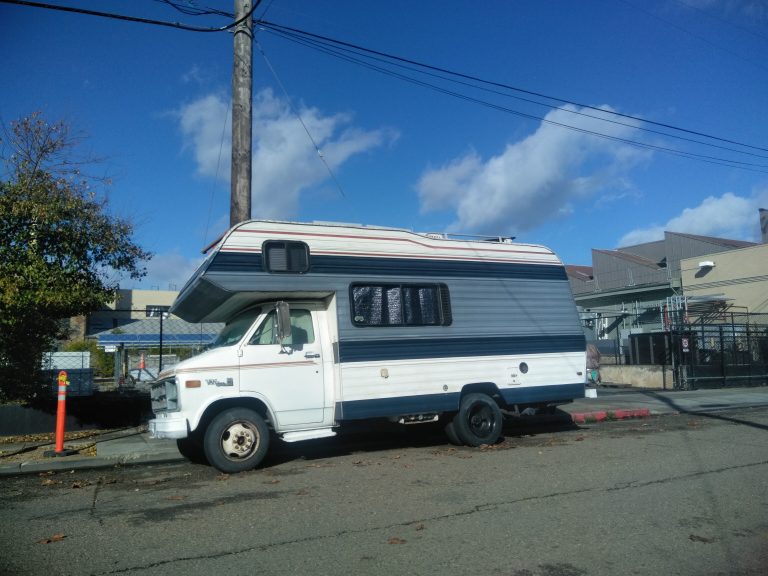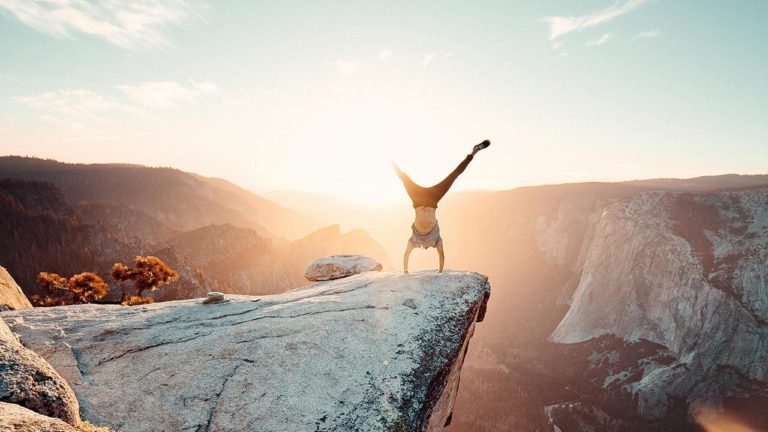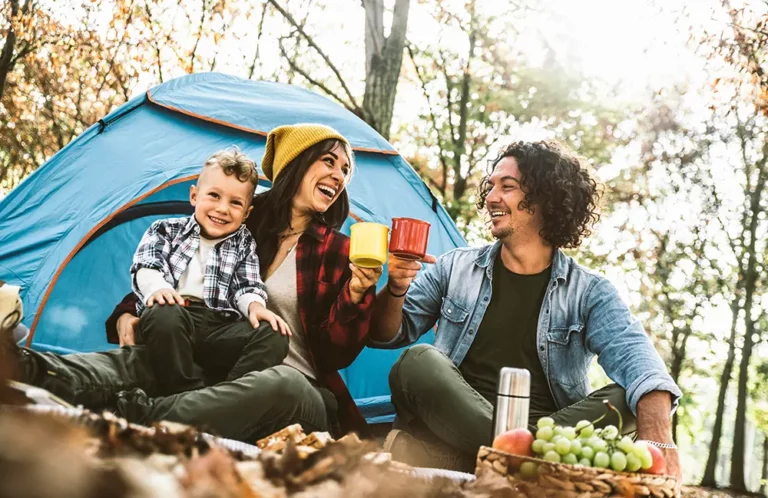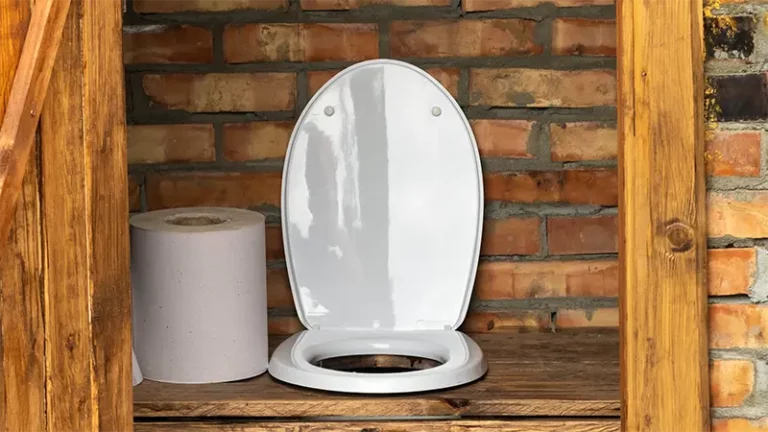The Allure of Van Life
Living in the van life isn’t just a lifestyle; it’s a movement. As we move towards a more remote and flexible work environment, many people are ditching the traditional living arrangements to embrace the freedom of the open road. Van life offers the opportunity to explore new places, live minimally, and break free from societal norms, all from the comfort of a mobile home. But while living the van life you still need necessities like water.
The Lifeline: Water
While van life offers unparalleled freedom, it comes with its own set of challenges, and one of the most pressing is the availability of water. In a stationary home, you rarely think about the source of your next glass of water, shower, or dishwashing session. However, when your home is on wheels, securing clean and safe water becomes a daily concern. Water is essential for drinking, cooking, cleaning, and personal hygiene; therefore, knowing how to find reliable sources becomes crucial.
The Aim of This Article
This article aims to be your comprehensive guide to finding and utilizing water and refill stations while living in a Sprinter van. From identifying types of water needed for different activities to the equipment required for storage, we’ll cover all the bases. We’ll also offer tips on how to locate water stations in both urban and rural settings, how to use apps and websites to make your search easier, and how to refill water in a safe and legal manner.
Whether you’re a van life veteran or a curious newbie, this guide will equip you with the knowledge to stay hydrated and clean, no matter where the road takes you.
The Role of Water in Day-to-Day Van Life
Living in a Sprinter van demands a shift in how we think about basic amenities, and water is at the top of that list. Unlike a traditional home where water is just a faucet turn away, in van life, you have to plan and ration. Here’s why water is a non-negotiable part of your daily life on the road:
Cooking
Preparing meals requires clean water for rinsing vegetables, boiling pasta, or making a simple cup of coffee. Without an accessible water source, your food options become severely limited.
Cleaning
Whether it’s washing dishes, cleaning cooking utensils, or wiping down surfaces, water is essential for maintaining cleanliness in the confined space of a Sprinter van.
Personal Hygiene
From brushing your teeth to washing your hands and face, personal hygiene takes a hit when water is scarce. Extended periods without adequate hygiene can lead to skin issues and other health concerns.
Emotional Well-being
A refreshing shower can be a morale booster, especially after a long day of driving or outdoor activities. The availability of water directly impacts your comfort and emotional well-being while on the road.
Potential Health Risks of Running Out of Clean Water
The absence of a reliable water source can quickly escalate into a health crisis. Here are some risks involved:
Dehydration
The most immediate concern is dehydration, which can cause fatigue, dizziness, and cognitive impairments. In severe cases, dehydration can lead to medical emergencies.
Foodborne Illnesses
Using contaminated water for cooking or cleaning can introduce harmful bacteria, leading to foodborne illnesses like E. coli or salmonella infections.
Skin Infections
Poor personal hygiene due to a lack of water can result in skin infections, fungal growth, and other dermatological issues.
Compromised Immune System
A combination of dehydration and poor hygiene can weaken your immune system, making you more susceptible to illnesses.
The availability of clean water is not just a matter of convenience; it’s a cornerstone of healthy living in a Sprinter van. Running out can compromise your health, hygiene, and overall well-being. As such, understanding how to find and utilize water sources becomes a skill as vital as any other for the van-living community.
Understanding and Managing Your Liquid Assets in a Sprinter Van
Living in a van requires a nuanced understanding of water usage. Not all water is created equal, and different activities necessitate different types of water. In this section, we delve into the various kinds of water you’ll need and discuss how to store each type effectively.
Drinking Water
When it comes to drinking water, quality is the top priority. This water must be free from any contaminants to ensure it is safe for consumption. The importance of having a clean water source for drinking cannot be overstated, as it directly impacts your health and well-being. For this reason, it’s advisable to store drinking water in food-grade water jugs or containers that have tight-sealing lids to prevent any possibility of contamination. Some van dwellers also invest in built-in water filtration systems that purify water for immediate consumption, providing an added layer of security.
Cooking Water
Cooking water is another crucial type that has similar quality requirements as drinking water. However, you may have a bit more flexibility here since the act of boiling can kill many types of bacteria and contaminants. This water is primarily used for boiling pasta, making soups and stews, and brewing coffee or tea. You could use separate, clearly labeled containers if you wish to keep your cooking water separate from drinking water. Alternatively, you can use the same high-quality water for both drinking and cooking but designate a specific portion just for culinary activities.
Cleaning Water
Cleaning water has a different set of requirements. While it doesn’t have to be of drinking quality, it should still be free from large particles and harmful chemicals that could damage surfaces or utensils. This water is mainly used for washing dishes, cleaning cooking utensils, and wiping down surfaces. Collapsible water containers can be very effective for storing cleaning water, as they can be expanded when a water source is available and collapsed to save space when empty. If your Sprinter van comes with a more sophisticated water system, you could have a separate faucet or spigot connected to a non-potable water tank designated for cleaning purposes.
Differentiating Between the Types
Differentiating between these types of water is crucial for both safety and convenience. One effective way to do this is by labeling your containers clearly. This ensures that you never accidentally use cleaning water for cooking or drinking, for example. Some people also prefer to use different colored containers for each type of water, making it easy to identify what each container holds at a glance. If your Sprinter van has a built-in water system, installing separate faucets for drinking and cleaning water can be a useful modification. Moreover, some of the more modern Sprinter vans come with digital systems that allow you to monitor the water levels in different tanks, which can be extremely helpful in managing your water supply effectively.
Understanding the different types of water needed for van life and employing appropriate storage solutions is essential for managing your water supply effectively. By being mindful of the quality and intended use of each type of water, you can create a more organized, efficient, and safer living environment. This not only ensures your health but also enhances the overall enjoyment and ease of your van life experience.
Tools and Equipment for Water Storage
When it comes to storing water in your Sprinter van, the right tools and equipment can make all the difference. Each storage option has its own set of advantages and drawbacks, and the best choice will depend on your specific needs, the amount of space available, and how long you plan to be on the road. In this section, we explore various options for water storage and how to choose the best fit for your van life.
Water Jugs
Water jugs are a simple yet effective way to store water. They are readily available, easy to fill, and come in a variety of sizes to fit your storage needs. These jugs are usually made from food-grade materials, ensuring that the water stored inside remains safe for consumption. They are also relatively easy to carry, making it convenient to fill them up at water stations. However, they can take up a considerable amount of space, and you’ll need to ensure they are securely stored to prevent spills while driving.
Built-in Water Tanks
For those willing to invest in a more permanent solution, built-in water tanks offer a seamless way to manage water storage. These tanks are often installed under the bed or the floor of the van, utilizing space that would otherwise go unused. They can store a larger volume of water, reducing the frequency of refills. Some are even equipped with electronic gauges that allow you to monitor water levels. However, installing a built-in tank can be costly and may require professional assistance. Additionally, these tanks are not easily removable, which means cleaning them can be a bit more challenging.
Collapsible Containers
Collapsible water containers offer a versatile and space-saving solution for water storage. When empty, these containers can be folded down to a fraction of their full size, making them easy to store. They are particularly useful for storing cleaning water or as a backup for your primary water supply. These containers are generally made from durable materials that can withstand the wear and tear of van life. However, they are not usually recommended for long-term storage of drinking water, as the material may not be food-grade and could compromise the water quality over time.
Water Purification Systems
While not a storage solution per se, water purification systems are an invaluable tool for ensuring that the water you collect is safe for consumption. Options range from portable water filters to more complex reverse osmosis systems that can be built into your van’s plumbing. These systems can purify water from less reliable sources, expanding your options when searching for water. However, they do require an initial investment, and some systems may need regular maintenance and filter replacements.
Selecting the right tools and equipment for water storage is a crucial aspect of successful van living. From simple water jugs to advanced built-in tanks and purification systems, there are options to suit every need and lifestyle. By carefully considering the pros and cons of each, you can make an informed decision that ensures you always have access to the water you need, no matter where your journey takes you.
Finding Water Sources for Van Life
One of the biggest challenges of van life is securing a reliable source of water. While the search can be more straightforward in urban areas, it often becomes a true test of resourcefulness when you’re out in rural settings. Regardless of where you find yourself, there are several places you can turn to when your water supply starts to dwindle. Here’s a guide on where to look based on your location.
Urban Areas
Grocery Stores
Grocery stores are among the most convenient places to find water in urban areas. Most stores have a section dedicated to bottled water, which you can purchase in various sizes, from small bottles to large multi-gallon jugs. Some grocery stores also offer refill stations where you can fill up your own containers at a lower cost than buying pre-packaged water.
Gas Stations
Gas stations are another reliable source for water, especially when you’re on the move. Many gas stations sell bottled water, and some even have outdoor water spigots. However, make sure to ask for permission if you intend to use these spigots, as not all are meant for public use. Some modern gas stations also have water vending machines where you can refill your jugs for a nominal fee.
Public Parks
Public parks often have water fountains or faucets where you can refill smaller containers. While this may not be the best option for large quantities, it can be a lifesaver when you’re in a pinch. Always test the water quality if possible, especially if the source is not clearly labeled as potable.
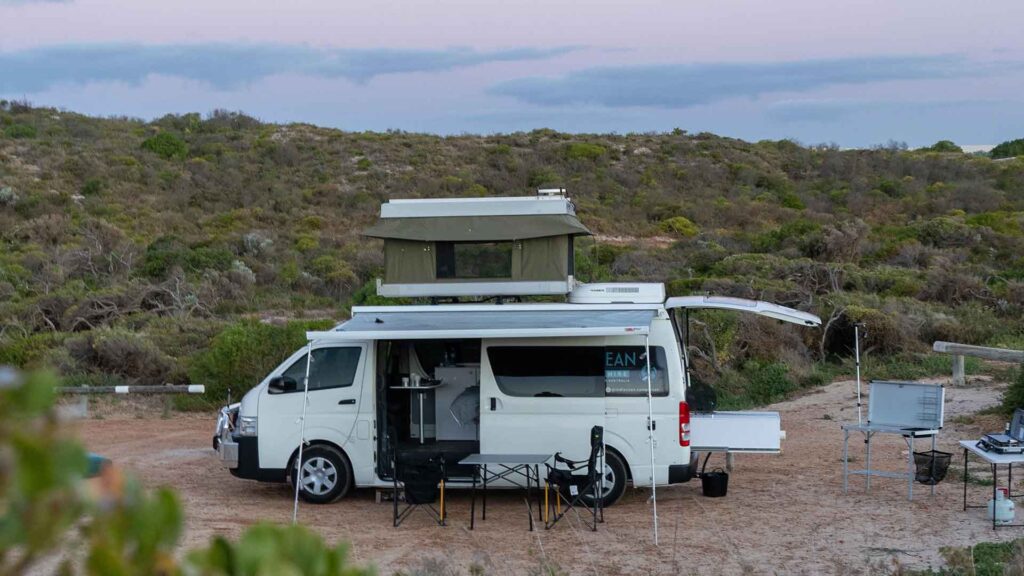
Rural Areas
Natural Water Sources like Rivers and Lakes
When you’re off the beaten path, natural water sources like rivers and lakes can be tempting options. However, caution is advised. Always assess the cleanliness of the source and treat the water appropriately before use, either by boiling, using water purification tablets, or a portable water filter. This is particularly crucial if you plan to use the water for drinking or cooking.
Campgrounds
Many campgrounds offer water refill stations or at least have a central faucet for campers to use. Some might charge a small fee for the service, but it’s usually more cost-effective than purchasing bottled water. Always check the water quality and confirm whether it’s potable before filling up your containers.
Visitor Centers
Visitor centers, often found in national parks or tourist destinations, sometimes offer water refill stations for travelers. These are generally well-maintained and offer high-quality, potable water. If you’re planning to explore a national park or similar area, checking the visitor center for water should be on your to-do list.
Finding water while living in a Sprinter van can be a straightforward task in urban areas but may require a bit more ingenuity in rural settings. From grocery stores and gas stations in the city to rivers, lakes, and campgrounds in the countryside, there are various options available. The key is to be resourceful, always prioritize safety by checking water quality, and have the necessary tools and equipment for water purification when needed. By knowing where to look, you can keep your water tanks filled and continue your van life adventures without worry.
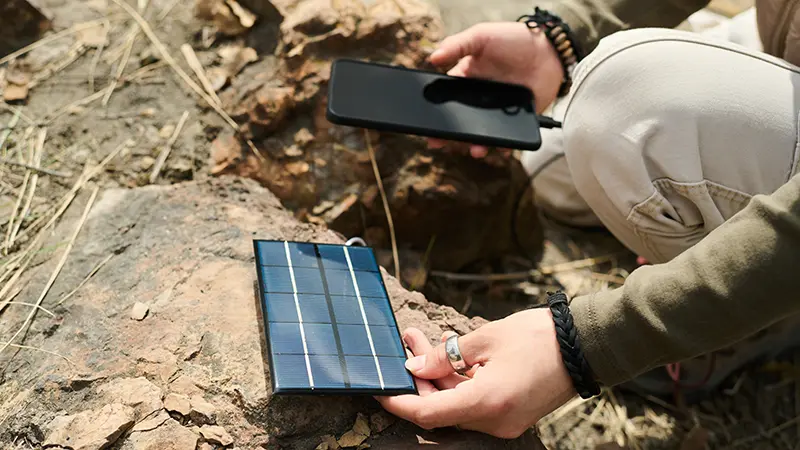
Using Apps and Websites to Locate Water Stations
In the era of smartphones and ubiquitous internet access, finding essential resources like water has become easier than ever. A variety of specialized apps and websites can help you locate water refill stations, whether you’re navigating city streets or exploring remote trails. Below, we delve into some popular digital tools for finding water, discussing their advantages and disadvantages.
iOverlander
iOverlander is a versatile app with a comprehensive database that extends beyond just water stations. It includes information on camping spots, mechanics, and other essential services that can be a boon for van dwellers. The platform relies on user-generated content, which ensures that the information is current. This feature makes iOverlander useful not just in the United States but globally. However, the user-generated nature of the content means that the quality and accuracy can vary. Additionally, the app’s effectiveness is constrained in areas with poor internet connectivity.
Tap
Tap is an app designed explicitly for finding water refill stations. Because of its singular focus, it is incredibly straightforward to use when you’re looking specifically for water. The app provides intricate details, such as the water quality and whether the source is free or requires payment. However, its scope is primarily urban and suburban, making it less useful for those venturing into rural areas. Its database also depends on businesses and organizations listing their refill stations, which means some potential sources might not be included.
Campendium
Campendium is tailored for the camping and RV community, providing information on various campgrounds that usually include water sources. The platform also allows users to post reviews, which often contain valuable insights into water quality, availability, and other amenities like showers and electrical hookups. However, its geographical scope is more focused on North America, limiting its utility for international travelers. Also, because it centers mainly on camping sites, it might not be the best resource for those who spend more time in urban settings.
Websites of National and State Parks
Many national and state parks have official websites that list the amenities available, including water stations. These sites can be very reliable for planning trips to natural reserves and parks in advance. However, the information is limited to the specific locations covered by the site and may not be updated as frequently as one would like. In such cases, it’s always a good idea to confirm the availability of resources upon arrival.
How to Refill Water Safely
Filling up your water containers isn’t just a logistical task; it also carries implications for your health and well-being. Whether you’re in a bustling city or remote countryside, knowing how to safely refill your water supply is crucial. Below, we elaborate on the steps to verify the cleanliness of a water source, explore various water treatment options, and provide tips for efficient water use.
Steps to Ensure the Water Source is Clean
Urban Areas
Before you start filling up your water containers in an urban setting, look for clear signage that indicates whether the water is potable. Public parks, campgrounds, and even some gas stations usually have water fountains or faucets with signs specifying if the water is safe for drinking. When in doubt, it’s always a good idea to consult local authorities or personnel managing the facility. If the source is a water vending machine, check for any certifications or inspection dates displayed, as these are usually regulated for water quality.
Rural Areas
When you’re relying on natural water sources in rural or remote areas, visual inspection becomes paramount. Always scrutinize the water for floating particles, algae blooms, or any signs of contamination like dead animals nearby. Also, be cautious of water that has a strange or chemical-like odor, or an unusual color. When you encounter these red flags, it’s best to seek an alternative source or be prepared to rigorously treat the water before use.
Water Treatment Options
Boiling
Boiling water is one of the most time-tested and effective methods of water purification. The process kills most types of bacteria, viruses, and parasites. The Centers for Disease Control and Prevention (CDC) recommends bringing water to a rolling boil for at least one minute. If you are at an altitude above 2,000 meters (about 6,562 feet), increase the boiling time to three minutes to account for the lower boiling point of water at high elevations.
Filtration
Portable water filters come in various shapes and sizes, from small straw-like filters to larger pump-action or gravity-fed systems. These filters work by passing water through a microscopic pore structure that traps harmful microorganisms. However, they generally do not remove viruses, so it’s important to use them in conjunction with other treatment methods when sourcing water from potentially contaminated areas. Always read the manufacturer’s instructions for proper use, cleaning, and maintenance to ensure the filter’s efficacy.
Chemical Treatment
Water purification tablets or liquid drops offer a lightweight and portable treatment option. These products typically use active ingredients like chlorine or iodine to kill microorganisms. While effective against many types of bacteria and viruses, chemical treatments can leave an unpleasant taste in the water. Some brands offer neutralizing tablets to improve the taste. Also, note that chemical treatment might not be effective against some cysts or parasites, so it’s often best used in combination with other treatment methods.
Tips for Efficient Water Use
Water-Saving Hacks
Small behavioral changes can result in substantial water savings. For instance, using a spray bottle filled with a soap and water mixture to pre-rinse dishes can drastically reduce the amount of water needed for washing. Likewise, turning off the faucet while brushing teeth or soaping hands can preserve several liters of water over time.
Reusing Grey Water
Grey water, or wastewater that’s not contaminated by human waste, can be reused for various non-potable tasks. This includes flushing a portable toilet or watering plants. If you plan to adopt this practice for the van life, make sure to use biodegradable, non-toxic soaps and detergents to prevent soil and water pollution. Also, store grey water in clearly labeled, separate containers to avoid accidental consumption.
Monitoring Water Levels
Keeping a vigilant eye on your water levels is essential, especially when you’re far from reliable water sources. Many modern Sprinter vans come with built-in digital monitoring systems that provide real-time data on water levels. If your van doesn’t have this feature, make it a habit to manually check your water supply at regular intervals. This will help you plan your water sourcing and rationing more effectively.
Safely refilling and efficiently using water are skills as crucial as any other in van life. By taking the extra time to verify the cleanliness of your water source and treating it when necessary, you can mitigate a host of potential health risks. Coupled with mindful water use, these practices can make your limited water supply go a long way, making your van life journey more comfortable and enjoyable.
Navigating the Rules and Social Norms of Water Collection in Van Life
Water collection isn’t just about physical logistics and safety; there are also legal and social dimensions to consider. Laws governing water collection can vary widely depending on the jurisdiction, and there are often unspoken rules of etiquette when using shared or public water sources. In this section, we delve into these considerations to help you navigate this complex landscape responsibly.
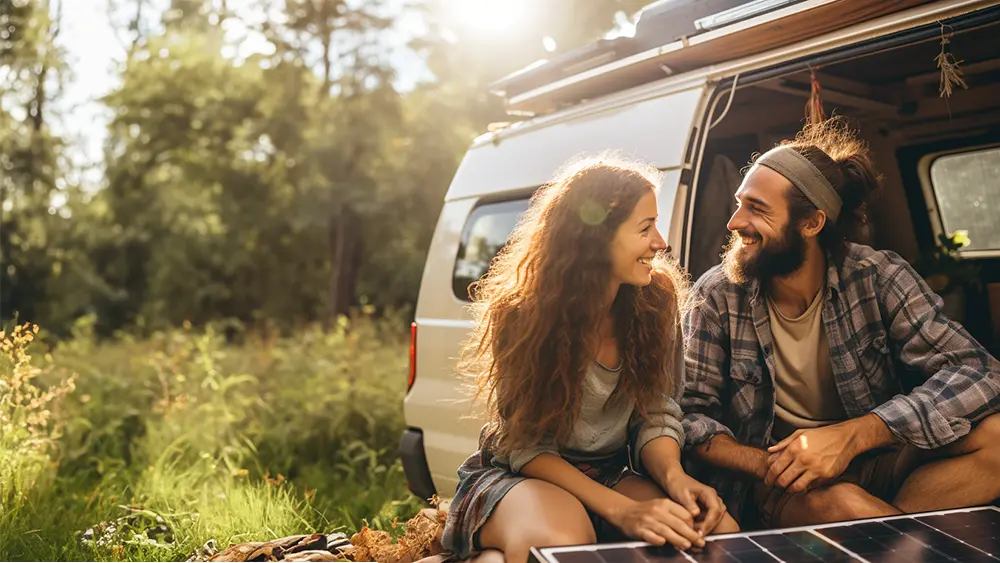
Laws and Regulations Around Water Collection
Public Areas
In public spaces like parks or rest areas, water is generally considered a public resource. However, this doesn’t mean you can freely tap into any available source. Always look for designated public faucets or water fountains. If you are unsure, it’s prudent to ask a park ranger or another authority figure. Some areas may have restrictions on the amount of water you can collect, especially in regions suffering from drought or water scarcity.
Private Property
Trespassing onto private property to collect water without permission is generally illegal and could lead to penalties. Always respect private lands and seek the owner’s consent before using their water source.
Natural Sources
Collecting water from natural sources like rivers, lakes, or springs often falls under the jurisdiction of local or federal agencies. Certain protected areas may require a permit for any form of resource collection, including water. Always do your research and abide by the rules of the area you are in.
Etiquette for Using Public or Shared Water Sources
When using public or shared water sources, it’s essential to be considerate of others. Here are some general guidelines to follow:
Waiting Your Turn
If there’s a line, wait your turn and try to fill your containers as quickly as possible to allow others access to the water source.
Cleanliness
Leave the area as clean as you found it. This is especially important for faucets or spigots that require you to touch them, as cleanliness helps ensure the safety of the water for everyone.
Minimize Waste
Try to avoid water wastage by making sure your containers are securely positioned before opening the tap. Spilled water is not just a waste; it can also create muddy, slippery conditions that may pose a safety hazard.
Summary
Finding and managing water effectively are vital skills for anyone embracing the Sprinter van lifestyle. From understanding the types of water you need and how to store them. To identifying reliable water sources and treating water for safe consumption, there are many facets to consider. Additionally, it’s crucial to be aware of the legal regulations and social etiquette surrounding water collection. As being responsible benefits not just you, but the entire community of van dwellers and the environment at large.
So as you embark on your Sprinter van journey, remember that water is your most essential travel companion. Stay hydrated, act responsibly, and make the most of the freedom and adventure that van life has to offer.
Additional Resources:
Navigating water sources can be a bit of a puzzle. But several apps and websites are designed to make this crucial aspect of van life easier. Here’s an expanded list to keep you well-hydrated on the road:
- iOverlander: A comprehensive app that includes a wide range of facilities, including water stations, camping spots, and other essential services.
- Tap: Specializes in locating water refill stations and provides details like water quality and whether the source is free or requires payment.
- Campendium: Aimed at the camping and RV community, this app offers information on campgrounds that include water sources.
- Websites of National and State Parks: These official sites often have accurate info on amenities, including water stations. This is especially useful for those planning to venture into natural reserves.
- Freecampsites.net: Although primarily focused on free camping sites, this website often includes details about available amenities, including water sources.
- RV Dump Sites: This app not only helps you find places to empty your waste tanks but also often includes information about fresh water fill-up stations.
- AllStays: This app is geared towards truckers and RVers, but it also includes valuable information about rest stops, many of which offer water refill stations.
- Water Point Map: This app focuses on rural and remote areas, providing information about natural water sources, including springs and wells.
Each of these apps and websites offers unique features and covers different geographic regions. By using a combination of these resources, you can make sure you’re never far from a water refill station, whether you’re in a bustling city or the middle of nowhere.
Recommendations for Water Storage and Purification Equipment
Water Storage
- Food-Grade Water Jugs: Reliable for storing large quantities of water. Look for ones with tight-sealing lids to prevent contamination.
- Built-in Water Tanks: A more permanent but effective solution, especially for those planning long trips.
- Collapsible Water Containers: Ideal for storing cleaning water and great for optimizing space.
Water Purification
- Portable Water Filters: Brands like LifeStraw or Sawyer offer portable filtration options effective against bacteria and protozoa.
- Boiling Equipment: A portable stove can be handy for boiling water when you don’t have access to electricity.
- Chemical Treatment: Water purification tablets like Potable Aqua or Aquamira offer a lightweight and portable way to treat water.
- Reverse Osmosis Systems: For those willing to invest in a built-in solution, a reverse osmosis system offers a high level of purification but can be costly and requires space.
By making use of these additional resources, you can ensure that you’re well-equipped to handle the water challenges that come with living in a Sprinter van. These tools and equipment not only make life more convenient but also add an extra layer of safety and security to your travels.
Conclusion: The Lifeline of Water in Your Sprinter Van Adventures
Water is more than just a daily necessity; it’s the lifeline that sustains us through every adventure and challenge that van life brings. From the importance of different types of water for various needs to the tools and equipment essential for storage, this guide has aimed to provide a comprehensive overview of managing your water resources while living in a Sprinter van.
We’ve explored various sources where you can find water, both in urban jungles and rural landscapes. We touched upon the significance of treating water to ensure its safety, and also discussed the legal and ethical considerations that come with water collection. Modern technology, too, has its role in making water management easier, as showcased by the variety of apps and websites designed to help you locate refill stations.
Managing water effectively isn’t just about quenching your thirst or having enough to cook a meal. It’s about planning, being aware of your surroundings, and, most importantly, being responsible and considerate. As you live the dream of freedom and adventure in your Sprinter van, always remember that with the liberty of life on the road comes the responsibility to use resources wisely and respectfully.
So, as you journey through cities, forests, deserts, and coasts, may you always find your water containers full and your adventures boundless. Stay hydrated, act responsibly, and soak in all that the beautiful world has to offer while enjoying your Sprinter van life to the fullest.
